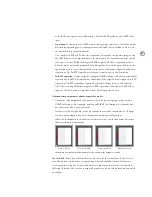
92
•
Proxy.
Sends screen-resolution data of placed images. Useful when image detail is not
important, such as for FPO-quality proofs. Printing will be faster than Optimized
Subsampling.
•
None.
Replaces each placed graphics frame with a large X, resulting in the fastest possible
print speed. In a service provider context, this setting may be useful for troubleshoot-
ing jobs by helping to determine whether images are causing a problem. Also useful for
proofing copy.
Font s se c t ion
Note that if duplicate font downloading options are available in the printer driver (by click-
ing the Printer button at the bottom of the Print dialog box), for best results use the settings
in the main InDesign print dialog box as described here.
Adobe InDesign CS also includes a new preference that lets you subset fonts that contain
large numbers of glyphs, such as Japanese fonts. For details, see “Subset control for large
character sets during output” on page 11.
Download menu:
Specifies how InDesign sends fonts required to print the document.
•
None.
Downloads only the references to the fonts. This is the appropriate option to
choose if the fonts reside in the printer and you are certain that the printer-resident fonts
are exactly the same version as the fonts on the host computer.
•
Complete.
Downloads all fonts for the publication at the beginning of the print job,
rather than page-by-page.
•
Subset.
Downloads to the printer only the characters (glyphs) used in the document.
Glyphs are downloaded once per page. InDesign sends each font subset under its own
name in the PostScript stream, preventing unwanted font substitution. Font subsets are
also slightly more efficient because they are smaller than sending down entire fonts.
Download PPD Fonts.
Downloads all fonts required for printing, even if those fonts reside
in the printer. If there is duplication, the fonts on the computer override the fonts on the
printer. This option is useful in the following cases:
•
The character set of the printer-resident version doesn’t match that of the computer ver-
sion. For example, when the font on the computer is a TrueType font and the font on the
printer is a Type 1 font.
•
Character outlines must be exact for trapping purposes, but there is doubt that the
outlines at the printer match the outlines used in the document.
•
The PPD is inaccurate.
















































